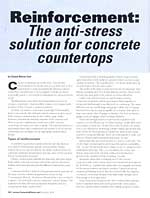 |
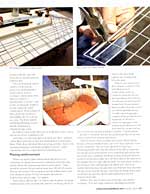 |
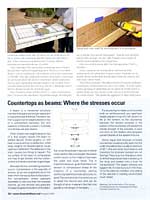 |
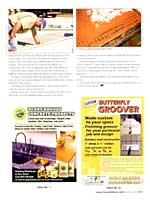 |
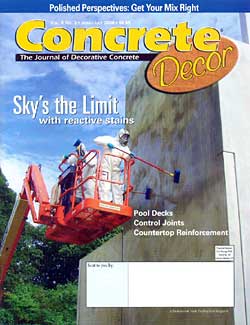
Reinforcement: The Anti-Stress Solution for Concrete Countertops
by Susan Brimo-Cox
Concrete countertops are works of art. They are also structural pieces of concrete. Just as you don't have to be a trained artist to create an aesthetically pleasing concrete countertop, you don't have to be an engineer to build one that is structurally sound - but it helps to understand the physical stresses at play 'Reinforcement is one of the most misunderstood topics in concrete countertops," observes Jethey Girard, a civil engineer and president of The Concrete Countertop Institute. Too little, too much - how much is just right? Unfortunately, there is not a simple role of thumb when it comes to reinforcement. Each concrete countertop has its own criteria: span, width, thickness, load and the material properties of the concrete itself What is critical to understand, Girard says, is that "concrete countertops are beams, not slabs on grade." He maintains that if you understand where load, compression and tension occur in concrete countertops you can figure out the appropriate reinforcement design.
Types of Reinforcement
It's probably a good idea to point out at the start that there are two kinds of reinforcement: primary and secondary. Primary reinforcement you can't do without. Secondary reinforcements can contribute additional characteristics that may make a better product, but are not absolutely necessary
Primary reinforcement materials are structural, plain and simple. Rebar ladder wire and structural carbon fiber grid are all primary reinforcement materials and each has different characteristics and uses.
Conventional rebar is indeed a strong reinforcement material, but for man), concrete countertop applications it's just too big.
Conventional 3/8-inch, 1/2-inch or 3/4-inch rebar is way too big for a typical 1 1/2-inch thick concrete countertop, 'Girard explains. "No material more than 3/16-inch in diameter should be used in a countertop less than 3 inches thick.'
Michael Karmody, a founding partner of Stone Soup Concrete, agrees that rebar is only useful in a situation where you have a large volume of concrete. "We typically pour 1-1/2 inches. Rebar takes up too much space and can cause cracks."
The profile of the rebar or steel used may also be important. Tom Ralston, president and CEO of Tom Ralston Concrete, observes that smooth bars don't grab to the concrete as well as ribbed bar.
Ladder wire and wire mesh are used by many concrete countertop contractors, and for good reason: Both materials are strong and small enough to use effectively in countertops. The major differences are the overall shape and gauge. Ladder wire is 9-gauge structural wire that is a narrow parallel set of strands. Wire mesh is large, open mesh, often 10-gauge in diameter, but there are heavier gauges, such as 6-gauge, which is a larger diameter.
Mesh with enough steel in it to provide the required tensile capacity is a very efficient way of reinforcing large, simple stabs (such as rectangles), Girard says. On the other hand, he points out, ladder wire is very efficient for reinforcing complex shapes and around sink holes, where the fixed spacing of welded wire mesh would require extensive cutting and splicing. 'Both can work together to make an, effective, efficient and economical reinforcing," he says.
Ralston likes flat wire mesh because it is caster to work with. "You Cut the shape you need and it can be used throughout a monolithic unit," he says. He has found that it is better to use 2.1 gauge for more substantial reinforcing. "Also, you can address the cornets and thinner areas with small, 1/4-inch stainless bar that has been grooved with a grinder for better bonding," he adds.
Structural carbon fiber is relatively new to the concrete countertop trade. John Carson, director of commercial development for TechFab LLC, explains that carbon fiber was originally developed for the pre-cast industry and used to produce CarbonCast pre-cast commercial building systems. But use of carbon fiber has migrated to concrete countertops because it has high tensile strength and is thin enough to fit in tight spots.
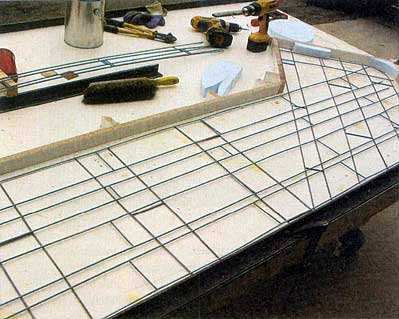 Some countertop contractors use other reinforcement materials, such as expanded metal, and report good results. Some experts, however, express concern related to the variable properties of some of these materials, especially when they are used for primary reinforcement.
Some countertop contractors use other reinforcement materials, such as expanded metal, and report good results. Some experts, however, express concern related to the variable properties of some of these materials, especially when they are used for primary reinforcement.
Fibers are frequently used in concrete countertop mix design, but reinforcing fibers should only be used as secondary reinforcement. Most fibers are synthetic polypropylene or nylon - and so they are physically unable to provide significant, tensile reinforcement. What a matrix of fibers in the mix can do is to help stabilize the wet concrete as it cures. The fibers help by distributing shrinkage stresses thereby minimizing or eliminating or eliminating large cracks.
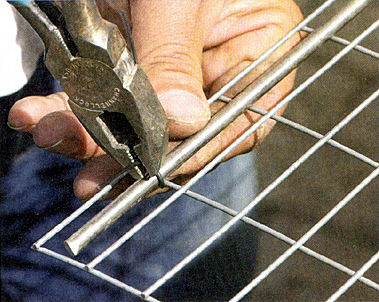 But Ralston cautions that fibers can be problematic if they clump up and are not mixed or dispersed well.
But Ralston cautions that fibers can be problematic if they clump up and are not mixed or dispersed well.
Some fibers are structural, such as hooked steel fibers, chopped carbon fibers, polyvinyl alcohol and chopped alkali-resistant glass fibers. While these individual fibers are strong, and they improve the mechanical properties and tensile strength of concrete, Girard cautions they are not a replacement for reinforcing steel.
Placing Reinforcement
Where you need to place reinforcement depends on your countertop. In Girard's view, because countertops are beams, they should all have the reinforcement placed in the bottom. "There should he between 1/4 inch and no more than 3/8 inch of concrete between the bottom of the countertop and the reinforcement. And there should be at least 1/2 inch of concrete between the reinforcement and any edge," he explains.
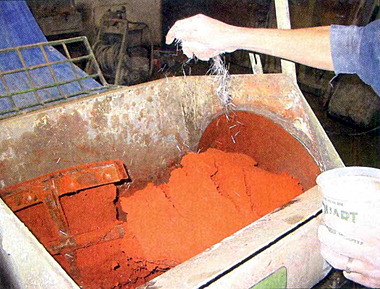 Ralston has a different Lake. He believes that the plastic shrinkage cracking begins at the top of the stab, thus the reinforcing should be closer to the top to hold together any cracking right from the onset.
Ralston has a different Lake. He believes that the plastic shrinkage cracking begins at the top of the stab, thus the reinforcing should be closer to the top to hold together any cracking right from the onset.
What if your countertop is also acting as a cantilever? You will definitely need reinforcement at the top. Girard recommends placingg the top reinforcement between 1/4 inch and 3/8 inch from the finished top. The recommendation remains the same even if you will be grinding the top. "Usually exposed aggregate countertops are ground down a maximum of 1/8 inch to expose the aggregate, so the reinforcing would start out 3/8 inch hour the top and end up
1/4 inch from the top after grinding is complete,' Girard explains.
Because it is relatively flat and strong, Karmody likes to use wire mesh in both bottom and top placemetals.
When he knows where a cantilevered section will go, Buddy Rhodes, of Buddy Rhodes Studio, uses a two-layer approach to beef up the countertop. "The two-layer approach is to put steel reinforcing (ladder wire) near the bottom of the slab to counteract the flexural forces at the bottom of the countertop and carbon fiber grid at the top to counteract the flexural forces produced when the cantilevered section has weight on it All this is done in the same pour. He explains that for a right-side-up mold, you pour about a third of the thickness of the slab and place the ladder wire, then pour another third and place the grid, then top off the last third and strike off, then trowel smooth. He says, conversely, an upside-down mold would have the grid first and the steel reinforcing in the top (bottom) of the slab.
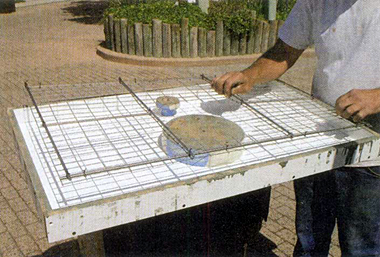 Ralston, who casts-in-place Most Of tile time, uses another technique: "If we have large cantilevers extending beyond the countertop cabinet more than 10 inches, we use small pieces of L bar to connect the countertop and then fasten wire and rebar to that." if the counter-Lop extends beyond 12 inches, Ralston sometimes recommends the use of corbels.
Ralston, who casts-in-place Most Of tile time, uses another technique: "If we have large cantilevers extending beyond the countertop cabinet more than 10 inches, we use small pieces of L bar to connect the countertop and then fasten wire and rebar to that." if the counter-Lop extends beyond 12 inches, Ralston sometimes recommends the use of corbels.
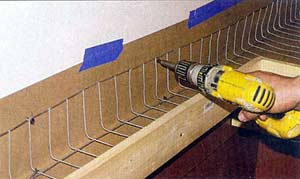
Galvanized wire used for reinforcement in a backsplash.
One could argue that cast-in-place countertops are not beams because there is plywood supporting them. However, if you think about it, even in construction, plywood isn't a structural component, it is flexible. Also, one could point out that cast-in-place countertops are not moved about like precast countertops. Girard emphasizes that the same engineering principles apply to cast-in-place, but he concedes reinforcement may not be as critical - shrinkage control and mix design are the dominant issues.
Dave Pettigrew, owner of Diamond D Co., cases countertops in place, he stresses the importance of good mix design, including the use of angular rock instead of pea gravel. "Angular rock interlocks and provides strength,' he says. Still, Pettigrew uses a variety of reinforcement materials in his countertops.
How does reinforcement affect the final appearance? Well, it shouldn't.
Some contractors are worried about rust forming the reinforcement isn't galvanized or epoxy coated Karmody says he actually doesn't mind a little rust because it helps the concrete and steel create a better bond.
What about ghosting? This phenomenon is frequently attributed to having the reinforcement too close to the surface. Actually, reports Girard, ghosting (or shadowing) occurs when the reinforcement is pushed down into the concrete or the concrete is poured through the reinforcement. "This pushes the aggregate (or larger sand grains) aside and forms a trench that fills in with the finer particles of the cement paste. The result is that the physical composition of the concrete above the reinforcing is different than the rest of the concrete." Because those lines of concrete are different in composition, they will cure differently and take stain differently.
Countertops as Beams: Where the Stresses Occur
A beam is a horizontal structural member that spans some open space and is supported near the ends. The beam can then support some weight placed on top of it somewhere between the end supports. A floor joist is a beam. Concrete countertops are also beams.
When a beam has weight placed on top of it, that weight causes the beam to deflect (bend). Small weights on stiff beams cause almost no deflection, while large weights on flexible beams cause significant deflection. The deflection in the beam causes two things to happen: The top surface of the beam is compressed and tries to get shorter, and the bottom surface is in tension and tries to get longer.
Between the two, something important occurs. Compression is the opposite of tension, so as one progresses down the beam from the top surface to the bottom, the compression stress gradually decreases to zero and then the stresses reverse, go into tension and gradually increase towards the bottom of the beam.
If an unreinforced beam has an asymmetrical cross-section (like a rectangle), the stress switch occurs at the midpoint between the upper and lower faces. This is important because, given that there is no tension or compression stress at the midpoint of a countertop, placing reinforcing steel there does absolutely no good. The point at which this switch occurs is called the neutral axis, and can be thought of as an imaginary line that runs parallel to the length of the beam.
If a countertop is made out of concrete (with no reinforcement), any significant weight placed on top of it will cause it to fail at the bottom of the countertop because the tension stresses in the bottom of the countertop will exceed the tensile strength of the concrete. A crack will form at the bottom and progress upward literally at the speed of sound.
Some argue that because concrete countertops usually actually span only the width of a cabinet box (usually a maximum of 36"), they are rather short beams, and therefore the stresses involved are not that high. This is true, but what about when an 8-foot long precast slab is picked up in the shop and loaded onto a truck for transportation? The largest stresses and biggest risk of cracking occur in the shop. Once the slabs are installed, only settling of the cabinets or building would impart much stress.
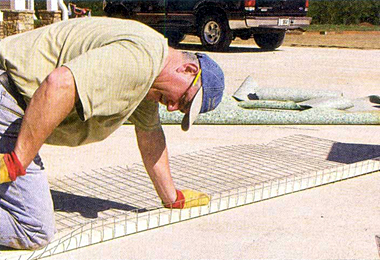 And what about surface fuzz if you use fiber reinforcement? Different contractors have different solutions to this pesky problem.
And what about surface fuzz if you use fiber reinforcement? Different contractors have different solutions to this pesky problem.
Pettigrew sands off any fiber fuzz and applies two clear finish coats, or he'll use a microtopping over a concrete blank that contains the fiber reinforcement.
Karmody says if he grinds the surface of the countertop he'll sometimes pour a veneer layer on top.
Rhodes points out, 'We use fibers in the back of the slab so they don't poke out of the finished surface and give you a hairy countertop. These hairs can be sanded or burned off, but it's better to avoid the peach fuzz."
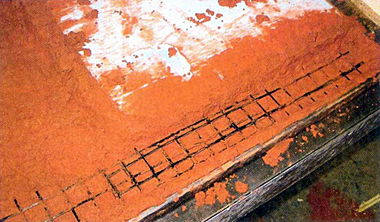
C-Grid is used around a sink hole.
When it comes to concrete countertops and reinforcement, Carson observes, "There's skill in creating concrete countertops and you haveto understand some of the design implications. There's a wide array of technologies that people use ... hut reinforcement is important."
Also important, says Ralston, are experience and analysis of the project. In the end, it all boils down to the right mix of reinforcement: not too little, not too much.
